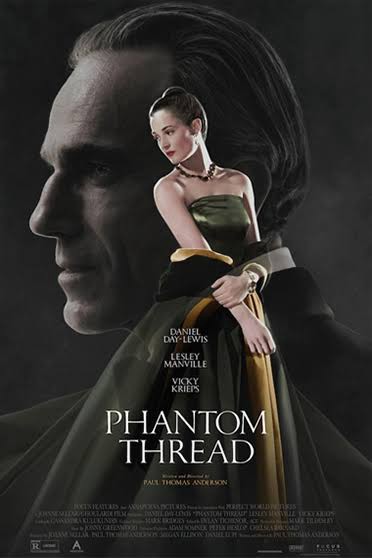The 1950’s-set drama Phantom Thread sees Paul Thomas Anderson and Daniel Day-Lewis team up again to excellent results.

Phantom Thread, Paul Thomas Anderson’s eighth film and second collaboration with Daniel Day-Lewis, is under a lot of pressure. The pair previously collaborated on 2007’s There Will Be Blood, which is considered by many critics to be one of the best films of the decade.
Phantom Thread can’t hope to live up to that, but it is a success in its own right. Bizarrely funny and led by the always-great Day-Lewis, the stylish period piece may astound casual viewers — but it definitely leaves an impression.
Set in the 1950s, Day-Lewis plays renowned dressmaker Reynolds Woodcock. He’s an artist devoted to his trade (he spends essentially every waking hour laboring on dresses), but he’s by no means a starving artist. His renown has earned him a bright white, elaborate mansion where most of the film takes place — and makes for a stunning set design.
Woodcock has meticulously designed a secluded world for himself, one that is nearly ruined when Alma Elson (Vicky Krieps) comes into it. She is a waitress Woodcock is immediately taken by, and he asks her out for dinner.
The date doesn’t go quite as she anticipated, and she ends up giving him her dress measurements instead. She moves into the mansion to serve as something between a model, a muse, a partner and a distraction — but now that she has his attention, she’ll stop at nothing to keep it.
It’s never quite clear what direction the movie is going to take until it’s already there. Anderson’s greatest strength is creating memorable worlds for his characters to inhabit. The film has a supple texture to it — you can practically feel the fabric running through your fingers as Woodcock carefully crafts the dresses. Matching Woodcock’s neuroticism, the film is antiseptic, precisely clean and cut.
The performances are nuanced enough to make an uninformed viewer believe they’re watching a biopic. As always, Day-Lewis fully inhabits his character. Anderson’s screenplay helps him tear through the layers of his character like running through a dress with scissors.
Krieps is given the almost insurmountable task of working opposite Day-Lewis and is largely successful. The story is just as much (perhaps more) Elson’s than Woodcock’s, and the pair of actors creates an almost visible whirlwind between them as the power struggle shifts back and forth.
Lesley Manville also delivers a memorable performance as Woodcock’s sister Cyril, the only person who knows how to put Woodcock in his place.
The story wends and weaves — the middle of the film is unexpectedly packed with laughs when both Woodcock and Elson strip away their layers and reveal themselves as the people they truly are, for better and (largely) for worse. Without spoilers, their relationship is not a straightforward one, and again Anderson’s layered script supplies them with more than enough material to shine.
In every dress, Woodcock says near the film’s beginning, he hides a message within the fabric so that it contains a piece of himself (hence the movie’s title). Something similar could be said for Day-Lewis’s stellar career.
Day-Lewis has said this will be his final role. It’s hard to fault the 60-year-old — this is only his sixth role in the 2000s, and his first since his award-winning turn as Abraham Lincoln in 2012’s Lincoln. He’s played a tortured miner, a bloodthirsty gangster and a struggling film director. In each role, he leaves a little piece of himself.
If this truly is his last role, he will be missed — but it’s hard to fault such a strenuously dedicated actor for leaving. And with this movie, he leaves on a worthy note. ••




